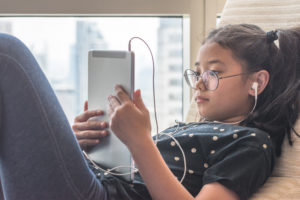December 1, 2022
By Nina Tahhan, BOptom, MPH, PhD, Senior Research Scientist at Brien Holden Vision Institute
When choosing a treatment, it is important to consider broader patient-specific factors such as likely compliance, finances, motivation, convenience, expectations, etc. Those at greater risk should be monitored more closely.

Myopia is commonly detected around 8 years of age and tends to progress through the late teens to early adult years at an average rate of 0.50D per year.1 However, there is a great deal of individual variation in the age of onset and rate of progression. These two factors influence the level of myopia that is ultimately reached.2 High levels of myopia are associated with a greater risk of sight-threatening complications,3 poorer quality of vision even when corrected,4 greater reductions in quality of life,5 and a higher lifetime financial burden.6 Hence, eye care practitioners play an important role in identifying those at the greatest risk of developing high myopia and imploring the most effective strategies to control myopia progression.
How Do We Identify Those at Greatest Risk of Fast Progression?
Multiple studies have shown that the strongest predictor of the rate of myopia progression is the age of onset. The younger the onset, the greater the rate of annual progression and the more likely the child will end up with high levels of myopia.5,7–11 Other factors purported to indicate that a child is likely to progress faster include a higher baseline level of myopia than average and previous evidence of progression of >0.50D/year.2 However, Brennan and colleagues12 caution that a child’s previous history of progression may not always be a reliable gauge of how they will continue to progress, and they suggest relying more heavily on the age of onset as an indicator instead. A Finnish study13 found that 50% of children who received their first pair of spectacles before the age of 12.8 years were likely to end up with high myopia. Hence, it is argued that myopia control should be more aggressive for any young myopic child less than 12 years.
A study investigating seasonal variation in myopia progression in an ethnically diverse cohort of 469 children aged <12 years has found that myopia progresses significantly faster in winter than in summer.14 Other general risk factors for the development and progression of childhood myopia that have been well documented15 include East Asian ethnicity, parental myopia, higher levels of education, and inadequate time spent outdoors. These risk factors and annualized progression data from Asian and Caucasian children wearing single vision lenses for myopia correction have been used to develop the Brien Holden Vision Institute Myopia Calculator. This calculator may be used as a tool for clinicians who wish to track progression relative to the general myopic population and to estimate the level of myopia control to be expected with different treatment options.
How Do We Select the Most Effective Myopia Management Therapy?
With an increasing number of new interventions available on the market and ever-evolving evidence around the efficacy of these interventions, it can be hard to keep pace. It is particularly challenging to interpret and compare when the literature evidence around efficacy is collated and reported in highly variable ways. For example, would findings from a study conducted in China be relevant to a European child, or would data from studies conducted on young children be relevant for older teenagers? How do we compare a treatment from one study where efficacy is reported as a percentage to another where efficacy is reported in millimeters or diopters? This challenge is indeed an ongoing issue for researchers. Gifford and Gifford have presented a paper comparing myopia control efficacy data from published randomized controlled trials over a 12-month period. It was found that, for most interventions, it was challenging to determine superiority due to the wide confidence intervals in treatment effect data and differences in control groups between trials. There were a few exceptions, however, with 0.01% atropine and center-distance +1.50 add multifocal lenses showing less effect than other treatments.16
Hence, when choosing a treatment, it is important to consider broader patient-specific factors such as likely compliance, finances, motivation, convenience, expectations, etc. Those at greater risk should be monitored more closely. If the intervention fails to result in adequate myopia control, consider whether there were issues with the treatment prior to considering alternatives, for example, compliance problems or periods of intense near work (exams, Covid). If they still do not provide adequate control, a stronger treatment (higher add power, higher concentrations), alternative treatments, or combination therapy may be considered. Research into the efficacy of combination therapies is sparse, but in recent trials, combination of atropine with orthokeratology shows promise.17
To make it easier for clinicians to keep pace with the rapidly evolving evidence around myopia control treatment efficacy, the International Myopia Institute has brought together leading researchers from around the world to produce a series of white papers that collate and summarize all the latest evidence. A new update is expected in 2023, where risk factors, management, and interventions will be reviewed, providing further insights into managing fast progressors from a clinical perspective.
 |
Dr. Nina Tahhan is a Senior Research Scientist at the Brien Holden Vision Institute, a Senior Conjoint Lecturer at the School of Optometry at UNSW, Project Director for the International Myopia Institute, and a member of the Vision Loss Expert Group. Dr. Tahhan has over 20 years of experience in the eye health sector in various areas, including clinical eye care to underserviced communities, delivery of eye care education to practitioners, optometry students, community health workers, and academics, and academic research. Her research areas have included orthokeratology, myopia control, soft contact lens performance and impact on ocular physiology, quality of life, ophthalmic epidemiology, and health economics. |
References
- Smith, M. J. & Walline, J. J. Controlling myopia progression in children and adolescents. Adolesc. Health. Med. Ther. 6, 133 (2015).
- Gifford, K. L. et al. IMI – Clinical Management Guidelines Report. Invest. Ophthalmol. Vis. Sci. 60, M184–M203 (2019).
- Haarman, A. E. G. et al. The Complications of Myopia: A Review and Meta-Analysis. Invest. Ophthalmol. Vis. Sci. 61, 49–49 (2020).
- Bullimore, M. A. & Brennan, N. A. Myopia Control: Why Each Diopter Matters. Optom. Vis. Sci. 96, 463–465 (2019).
- Sankaridurg, P. et al. IMI Impact of Myopia. Invest. Ophthalmol. Vis. Sci. 62, 2–2 (2021).
- Fricke, T. R. et al. Establishing a method to estimate the effect of antimyopia management options on lifetime cost of myopia. Br. J. Ophthalmol. bjophthalmol-2021-320318 (2022) doi:10.1136/BJOPHTHALMOL-2021-320318.
- Sankaridurg, P. R. & Holden, B. A. Practical applications to modify and control the development of ametropia. Eye 28, 134 (2014).
- Price, H. et al. The Cambridge anti-myopia study: Variables associated with myopia progression. Optom. Vis. Sci. 90, 1274–1283 (2013).
- Chua, S. Y. L. et al. Age of onset of myopia predicts risk of high myopia in later childhood in myopic Singapore children. Ophthalmic Physiol. Opt. 36, 388–394 (2016).
- Hardy, R. et al. Myopia Stabilization and Associated Factors Among Participants in the Correction of Myopia Evaluation Trial (COMET). Invest. Ophthalmol. Vis. Sci. 54, 7871 (2013).
- Donovan, L. et al. Myopia progression rates in urban children wearing single-vision spectacles. Optom. Vis. Sci. 89, 27–32 (2012).
- Brennan, N. A., Toubouti, Y. M., Cheng, X. & Bullimore, M. A. Efficacy in myopia control. Prog. Retin. Eye Res. 83, 100923 (2021).
- Pärssinen, O., Kauppinen, M. & Viljanen, A. The progression of myopia from its onset at age 8-12 to adulthood and the influence of heredity and external factors on myopic progression. A 23-year follow-up study. Acta Ophthalmol. 92, 730–739 (2014).
- Gwiazda, J. et al. Seasonal Variations in the Progression of Myopia in Children Enrolled in the Correction of Myopia Evaluation Trial. Invest. Ophthalmol. Vis. Sci. 55, 752–758 (2014).
- Morgan, I. G. et al. IMI Risk Factors for Myopia. Invest. Ophthalmol. Vis. Sci. 62, 3–3 (2021).
- Gifford, P. & Gifford, K. Descriptive statistical comparison of interventions for myopia control – a new analysis. International Myopia Conference (2022).
- Wildsoet, C. F. et al. IMI – Interventions for Controlling Myopia Onset and Progression Report. Invest. Ophthalmol. Vis. Sci. 60, M106–M131 (2019).













